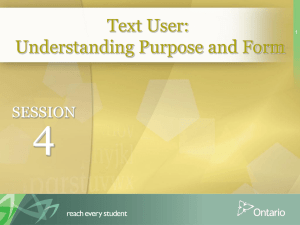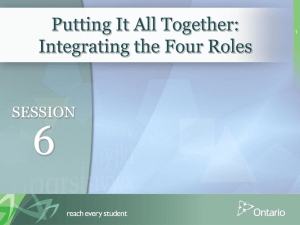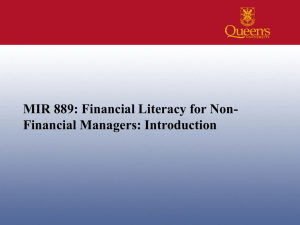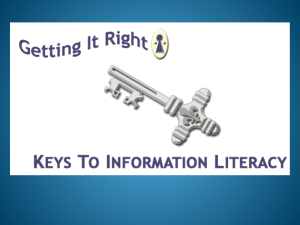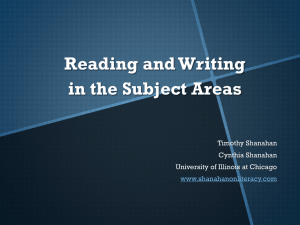Overview of the Sessions
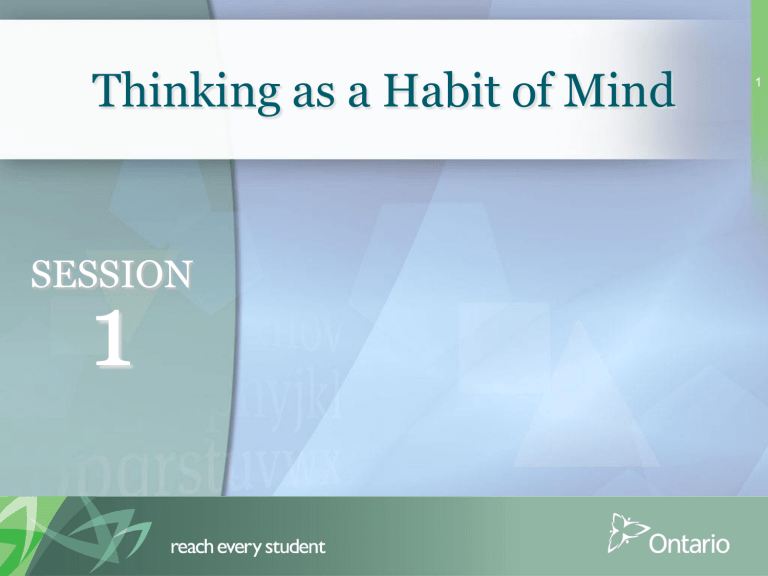
Thinking as a Habit of Mind
1
SESSION
1
Overview
A learning resource for educators with six sessions:
1.
Thinking as a Habit of Mind
2.
Meaning Maker: Interacting with Text
3.
Code User: Breaking the Code
4.
Text User: Understanding Purpose and Form
5.
Text Analyzer: Critically Thinking about Text
6.
Putting It All Together: Integrating the Four Roles
2
Thinking about Thinking: Setting the Stage for Independent Reading
Key Messages
• Early primary students are capable of thinking about their own thinking.
• The four roles of the literate learner model supports higher-order thinking in K–
2 classrooms.
• The Guides to Effective Literacy Instruction, Grades 4
to 6 support all teachers in planning effective literacy instruction.
• Higher-order thinking is not about a series of events or lessons, but rather about developing a habit of mind.
3
Thinking about Thinking: Setting the Stage for Independent Reading
Learning Goals for Session 1
4
This session is intended to:
• define higher-order thinking
• introduce the four roles of the literate learner
• explore strategies and processes that promote metacognition
• examine Guide to Effective Literacy
Instruction – Volume One
Thinking about Thinking: Setting the Stage for Independent Reading
The Four Roles of the Literate Learner
“Literacy in the twenty-first century involves not a single skill but a complex combination of skills and resources that the literate learner draws upon to make meaning from texts of many types. One approach to understanding this complex process is offered by Peter Freebody and Allan Luke in their ‘Four Resources Model’ (1990). The four resources are also referred to as ‘four roles’ or ‘four families of practice’.”
Guide to Effective Literacy Instruction –
Volume One, 2006, p. 28
5
Thinking about Thinking: Setting the Stage for Independent Reading
Four Roles of the Literate Learner
Meaning Maker Code User
Uses prior knowledge and experience to construct and communicate meaning when reading, writing, and speaking
Recognizes and uses the features and structures of written, visual, and spoken texts, including the alphabet, sounds in words, spelling, conventions, sentence structure, text organization, graphics and other visuals
The Literate Learner
Text User Text Analyzer
Understands that the purpose and audience help to determine the way a text is structured, the tone, the degree of formality, and the sequence of components, and uses this knowledge to read, write, and speak
Understands that texts are not neutral, that they represent particular views and perspectives, that other views and perspectives may be missing, and that the design and messages of texts can be critiqued and alternatives considered
Found on page 9 of Literacy for Learning: The Report of the Expert Panel on Literacy in
Grades 4 to 6 in Ontario (2004). Based on Freebody and Luke’s “Four Resources Model”
(1990). The Expert Panel elaborated on the four resources model to suggest four roles of a developing junior learner.
Thinking about Thinking: Setting the Stage for Independent Reading
6
Evolving View: Four Roles of the Literate Learner
7
Adapted from page 9 of Literacy for Learning: The Report of the Expert Panel on Literacy in Grades 4 to 6 in
Ontario
(2004). Based on Freebody and Luke’s “Four Resources Model” (1990). The Expert Panel elaborated on the four resources model to suggest four roles of a developing junior learner. The Evolving View: Four
Roles of the Literate Learner is for discussion purposes only and is based on the work of the Collaborative
Inquiry in Literacy 2008
–09 and 2009–10.
Thinking about Thinking: Setting the Stage for Independent Reading
• Examine the principles of the Language
Curriculum document
(page 4).
• How are these principles embedded in the four roles of the literate learner model?
• How are these language principles captured in the introductory sections of the Kindergarten and Full Day Early
Learning documents?
Thinking about Thinking: Setting the Stage for Independent Reading
8
Graffiti Placemat
HIGHER-ORDER
THINKING
CRITICAL THINKING
CRITICAL LITERACY METACOGNITION
Individually record your thoughts regarding each term on the corresponding portion of your chart.
Thinking about Thinking: Setting the Stage for Independent Reading
9
Stepping Back: Think about
Thinking
10
All students are capable of critically analyzing and responding to texts.
1.
Read “Metacognition and Critical
Literacy” pages 60–64 of A Guide to Effective Literacy
Instruction – Volume One
2.
Read Critical Thinking and
Critical Literacy ” pages 45–46 of The Full Day Early Learning
Kindergarten Program
Thinking about Thinking: Setting the Stage for Independent Reading
Let’s talk about metacognitive thinking!
Hand Up, Pair Up
1.
Choose a quote.
2.
Read it and think about its meaning.
3.
Raise your hand when you are ready to share your thinking about the quote.
4.
Find a partner and share your thoughts.
5.
Exchange your quotes.
6.
Move again and find a new partner.
7.
Return to your table and share your thinking with the group.
11
Thinking about Thinking: Setting the Stage for Independent Reading
“Metacognition is not something you plan into your schedule, but rather, something you do in your day-to-day teaching
Guylaine Melançon, 2005
Gradual Release of Responsibility Model
Teacher Responsibility
12
Student Responsibility
Source: From "Productive Work Group: How to Engage Students, Build Teamwork, and
Promote Understanding" (p. 7), by Nancy Frey, Douglas Fisher & Sandy Everlove,
Alexandria, VA: ASCS, © 2009 by ASCD, Reprinted and adapted with permission. Learn more about ASCD at www.ascd.org .
Thinking about Thinking: Setting the Stage for Independent Reading
Making Thinking Visible
13
“Effective thinkers make their thinking visible, meaning they externalize their thoughts through speaking, writing, drawing or some other method.”
– David Perkins, 2010
Harvard’s Project Zero
Thinking about Thinking: Setting the Stage for Independent Reading
Creating a Thinking Environment
14
View videos on the web:
Routines Working Toward
Independence (Kindergarten)
Reviewing Reading Strategies
(Grade 1)
Thinking about Thinking: Setting the Stage for Independent Reading
Develop a Language for Thinking
• What do I already know about this topic/author?
• Why am I reading this text?
• How does this text work?
• How will I read this text?
• What strategies can I use to read this text?
• What words are new to me?
• What did I learn about my reading/writing today?
• I’m thinking that …
Thinking about Thinking: Setting the Stage for Independent Reading
15
Visible Thinking
View a video on the web:
Learning Goals: Mind-mapping
Reading Strategies (Grade 2)
16
Thinking about Thinking: Setting the Stage for Independent Reading
Teach Thinking Routines
Think, Puzzle, Explore
Connect, Extend,
Challenge
Think, Pair, Share
See, Think, Wonder
I used to think… now I think
What makes you say that?
A thinking routine:
• is goal oriented in that it targets specific types of thinking
• gets used over and over again in the classroom
• consists of only a few steps
• is easy to learn and teach
• can be used across a variety of contexts
• can be used by the group or by the individual
– David Perkins, 2010
Harvard’s Project Zero
17
Thinking about Thinking: Setting the Stage for Independent Reading
Creating a Thinking
Environment
Create an environment where…
• Students take increasing responsibility for planning and regulating their learning.
• Students challenge their understanding of themselves as learners.
• Students have clear learning goals so they learn to think and ask questions of themselves as learners.
• Learning looks different for different learners.
18
Thinking about Thinking: Setting the Stage for Independent Reading
Talking to Problem-Solve
View a video on the web:
Talking to Problem-Solve
(Grade 1)
19
Thinking about Thinking: Setting the Stage for Independent Reading
Inquiry Habit of Mind
• What opportunities do your students have to demonstrate their thinking?
• What do your students need to develop their thinking as a habit of mind?
• What will you focus on next in your classroom?
• What will be your next step?
20
Thinking about Thinking: Setting the Stage for Independent Reading
Inquiry Habit of Mind
21
What is the impact of __________________ (teacher practice) on ________________________ (change in student learning) ?
Thinking about Thinking: Setting the Stage for Independent Reading
Hand-outs and Reference Documents
22
All resource and curriculum documents used in Thinking
about Thinking sessions are available online in PDF. Please visit the following web page to download them: http://resources.curriculum.org/LNS/thinking/session1.html
Thinking about Thinking: Setting the Stage for Independent Reading

